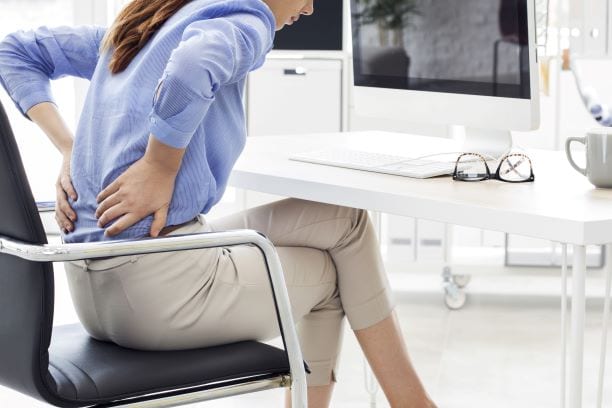Are you wondering about the source of back pain?
Do you wake up to low back pain? Do you feel a sharp pain every time you stand up after sitting for a while? Do you feel a need to sit after standing for a while just to take the pressure off your back?
At least 80% of all people suffer from back pain at some point in their lives. What if I told you, your back pain had nothing to do with your back? The source of back pain lies elsewhere in the body.
Three Simple Tests to Find Out Your Source of Back Pain
Test One – Is it Your Quads?
After sitting or lying for a while, you stand up, and you feel pain in your low back. The pain can be sharp enough to drop you to your knees, or it may be a dull pain that just feels like something will break or tear if you stand straight. Does the pain or stiffness go away once you sit down?
Chances are the source of back pain can be in your quads (front of your thighs) or your inner thighs. If the pain is more to the outside of your back, then that is sign it is coming from the quads. If the pain is more in the center of your low back, it is coming from your inner thighs. The same is true if your back hurts after standing for a while and you feel a need to sit down to take the pressure off your back. Again, the source of back pain is coming from your quads or inner thighs.
Test Two – Is it Your Hamstrings?
If your back hurts while sitting and you feel a need to stand to get it to stop, then it is your hamstrings (back of your thighs). This type of low back pain is not as common as the above test where quads or inner thighs were the culprits. Though most people have tight hamstrings, its an issue that is masked when we choose a soft chair as a solution. It allows us to ignore the pain for a while, but it, and the source of back pain, is still there in the tight hamstrings.
Test Three – Is it Your Inner Thighs?
Test your inner thighs. Sit in a chair and place one of your ankles on the knee of the opposite leg. Does your knee lay flat or stick up? It should lay flat. You may not even be able to get your ankle up to your knee. Trust me, this is not an age issue. This is a problem with an inner thigh muscle and/or hip rotating muscles. This is a source of back pain but can also lead to hip joint problems if left unaddressed.
Understanding the true source of back pain can prevent you from dealing later with a herniated disc, bulging disc, pinched nerve, or joint damage. Like metal rubbing against another piece of metal, bones rubbing against another bone will cause damage to the bone.
Think of your muscles as rubber bands. The more tension you place on the rubber bands, muscles, the more they pull the bones closer together. Remember, bones cannot move on their own without the muscles. Think of someone that is totally paralyzed. They have all their bones, but their muscles will not move them.
How Can You Solve this?
Tight Quads Causing Back Pain
Surprisingly, the solution is amazingly simple. If you find the source of back pain is in your quads, then simply lie on your side, grab the ankle of the top foot, and gently pull your knee back behind your torso. Hold this for 5 seconds and repeat 10 times. It does not matter how far back your knee goes, just focus on letting the muscle release. The distance your knee travels will improve automatically. If you have a knee replacement or cannot grab your foot, use your yoga strap, rope, or belt by wrapping it around your ankle to extend your arm. Be sure to stretch both legs.
Tight Inner Thighs Causing Back Pain
If the source of back pain is your inner thigh, sit in a hardbacked chair, place one ankle on top of your opposite knee, and use your hand as a weight on the knee of the crossed leg. Feel the muscle in the inner thigh releasing and you will see the knee begin to lay flat. Be sure to stretch both legs.
Tight Hamstrings Causing Back Pain
If the source of back pain is in your hamstrings, check out the video for the hamstrings stretch here. Make sure you stretch both legs and all three hamstrings.
Stretching Your Body Daily is Necessary
Watch your pet, if you have one, and you will see they stretch several times a day. You should too. Our muscles are both emotional and physical. Unfortunately, we learn more about the physical side and stretching muscles physically alone leaves the job half completed. NO matter how much you stretch, if you do not release your muscles emotionally, your pain will always come back.
The Stretch n’ Release Technique differs from other common treatments in that we address the source of tension and go beyond simple stretching. By combining stretching with the training of your brain to learn to not fight back, you can release the emotional tension behind your pain.
In a typical session with a client, whether in person or by Zoom, we look at the dynamics of your back pain and root out the source of the tension. Then I demonstrate how to utilize the Stretch n’ Release Technique and daily stretches to relieve back pain for good.
Interested? you can learn more here in my recent video or sign up for a complimentary 30-minute session on Zoom.


